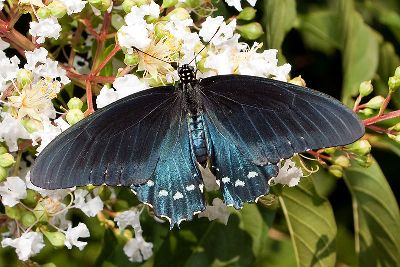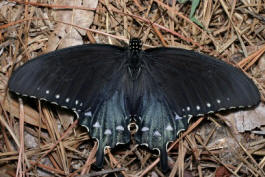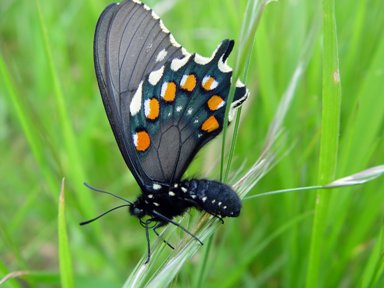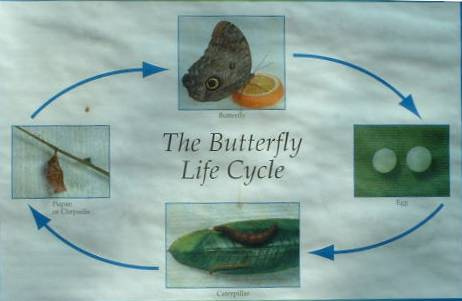Reproduction
"The caterpillar does all the work, but the butterfly gets all the publicity." - George Carlin
Battus philenor goes though complete metamorphosis which consists of four stages of the butterflies life: egg, larva, pupa and adult (Wilson, 2008). More specifically, they undergo holometabolous metamorphous which means that the larva looks completely different from the adult form. The fertilization of Battus philenor is the same as many other organisms. The egg is produced by the female which is fertilized by the sperm of the male.
Image courtesy of Wikimedia Commons. The picture above shows the four stages of
a butterfly life cycle.
Battus philenor display sexual dimorphism. Sexual dimorphism is when
the males and females look different. The female Battus philenor are
less colorful than the males and display large white spots on the margin
of the forewing (Mikula, 1997). The male Battus philenor has vibrant
colors of metallic blue or green coloration on the hindwings of the
butterfly (Mikula, 1997). When the Battus philenor is resting there is a
row of orange colored dots underneath the wings (fcps.edu).


Image courtesy of Wikimedia Commons for the two pictures of above. The
pictures above show the differences in the male and female Battus
philenor. The picture on the right is a female and the picture on
the left is a male.
The male Battus philenor spends most of his time looking for a female (Ramos, 2001). Have you ever wondered how butterflies can recognize each other? Well butterflies recognize each other through pheromones or scents (Wilson, 2008). Once the male has found a female they mate. The male has clasping organs that he uses to hold onto the female (Wilson, 2008). Butterflies mate end to end at their abdomens. From the mating process, the male gives the female spermatophore (Wilson, 2008). Spermatophore is a package of sperm and nutrients the female needs to produce and lay eggs (Wilson, 2008). The female stores the sperm in a sac called a bursa (Wilson, 2008). The female then fertilizes the eggs as she lays them on the host plant using the last sperm she received first (Wilson, 2008). The host plant for Battus philenor are plants from the family Aristolochiaceae. To learn more about the diet of the Battus philenor go to Nutrition. The eggs are only laid on the plants of the Family Aristolochiaceae because these plants contain compounds that the larva uses for a defense mechanism (Schappert, 2000). To learn more about the defense mechanism see Adaptations.
.jpg)
Image courtesy of Jeffrey Pippen. The picture to the right shows
Battus philenor mating.
Once the butterflies have mated, the female then searches for a host plant to lay her eggs on. The female lays her eggs on the underside of the leaf or on the stem. The female does this to hide her eggs from predators and so when the eggs hatch they can immediately start eating the leaves. The eggs are laid in clusters of one to twenty and are a bright orange color (Mikula, 1997). The eggs need to be laid in the precise temperature and humidity. If there is too much humidity, the egg will rot or be attacked by fungus; if there is too little humidity, the egg will crack. (Wilson, 2008). To learn about Battus philenor interaction with other organisms go to the Interaction page.
.jpg) Image
courtesy of Flickr. The picture to the left shows Battus philenor
eggs that have been recently laid on a host plant. To learn more about why
Battus philenor lay eggs on certain plants, go to the
Adaptation page.
Image
courtesy of Flickr. The picture to the left shows Battus philenor
eggs that have been recently laid on a host plant. To learn more about why
Battus philenor lay eggs on certain plants, go to the
Adaptation page.
The next stage of the life for Battus philenor is the pupal stage which occurs after the eggs hatch. The job of the pupa is to eat (Wilson, 2008). Battus philenor caterpillars eat the host plant so then they can contain certain compounds from the host plant as a defense mechanism. In the beginning stages of the pupa they feed in groups, but as they get older, they become more solitary (butterfliesandmoths.org). These caterpillars have an extreme look about them. The coloration of the caterpillars depends on the surrounding temperature (Fordyce, 2005). The caterpillars can be either red or black. The larva will molt several times before it reaches the next the stage. The caterpillar needs to molt in order to grow because the exoskeleton does not grow with the organism. The larvae has red projections coming off them with spots down their back (Ramos, 2001). The caterpillars have a structure behind their head called an osmeterium, which is a fork-like structure behind the head that emits a scent to warn predators if they feel offended (Hadley, Swallowtails). To learn more about this defense system go to Adaptations. When the caterpillars are full grown they are about two inches long (fcps.edu).
In a study done by Fordyce, J. et. al., they investigated if the color of Battus philenor larvae is a phenotypical change in response to temperature. If this was true they wanted to know if the behavior of Battus philenor climbing non-host plants was to reduce body temperature. The results of this study was that Battus philenor larvae may change color and participate in a climbing behavior to avoid extreme heat. The results showed that the when the daily temperature had increased more of the larvae were red and when the temperature was colder more of the larvae were black. This suggests that color is based more on climate than heredity. Climbing to new heights allowed the larvae to get away from the soil surface and which may increase cooling (Fordyce, 2005).
The pictures below show Battus philenor larvae. The red larvae can be found in warmer climates and the black larvae can be found in cooler climates.
.jpg)
.jpg)
Image courtesy of Jeffrey Pippen. Image courtesy of Flickr.
Eventually the caterpillar will turn into a chrysalis that can be green or brown (Mikula, 1997). The chrysalis has many different horns and curves. The posterior end of the chrysalis has an inward curve while the thorax is raised and the anterior part of the chrysalis has a pair of horns (Ramos, 2001). In temperate regions, the chrysalis is used to survive through the long, cold winters. When the adult Battus philenor emerges from the chrysalis, it has a swollen abdomen and shriveled wings (Hadley, Swallowtails). In the first hours of the butterfly’s life, the butterfly pumps hemolymph into the veins of the wings (Hadley, Swallowtails). This allows the butterflies wings to expand and smooth out. The waste product of metamorphosis is a red liquid that expels from the anus that is called meconium (Hadley, Swallowtails). Once the butterfly is able to fly, they can immediately start mating and the life cycle continues.
.jpg)
.jpg)
Image courtesy of Jeffery Pippen.
Image courtesy of Jeffrey Pippen.
The pictures above show a Battus philenor green chrysalis attached to a wall. The chrysalis can also be brown.
To continue learning about the Battus philenor go to Interactions.
.jpg)
.jpg)

